Tips for effective salmonella control

DEFRA updated its guidance for egg producers on poultry testing for salmonella this summer. Tony McDougal spoke to Avivets’ Will Garton about what farmers should do to avoid salmonella.
Poultry farmers should look to embrace the latest technologies as part of managing or limiting salmonella on farms. This should include evaluating the role of probiotics or the inclusion of competitive exclusion products in the diet of layers to help protect against salmonella infection.
Supplementation of probiotics has been shown in scientific studies to rapidly clear the ceca of birds and has the added benefit of being seen as safe to the consumer, being bile-resistant and producing a range of antimicrobial peptides.
The use of competitive exclusion products in the diet support the naturally occurring beneficial bacteria of intestinal microflora, resulting in a negative effect on pathogen bacteria, and thus the shedding of salmonella is reduced.
Will Garton, of poultry veterinarian Avivets said competitive exclusion products have generally been used as part of an attempt to help clear or reduce the risk of salmonella on farms: “I don’t think enough people are turning to this natural use. Antibiotics really cannot be used as part of a controlled strategy for salmonella and I believe the products do have an important role to play in the future.”
Measured response
Poultry are considered one of the most important salmonella reservoirs and both biosecurity and hygiene play a crucial role in keeping the disease at bay. Rats and vermin are key reservoirs of salmonella and it is important to have a good rodent control programme and ensure that pigeons and other wild birds are kept away from all areas.
“It is important to consider the peripheral areas of the range and not to think that out of sight means out of mind. Egg rooms are another area where salmonella can take root. They are used on a daily basis and farmers should ensure that there are no wild birds able to fly in and out of open doors.”
Feed is another important source of contamination in flocks. Grains, meal worms and even environmental dust can be common source of feed contamination. While pelleting feedstuffs will destroy almost all bacteria, recontamination may occur in the cooler environment or from dust and insects.
Unlike avian influenza which has a relatively short half-life, salmonella can remain dormant for up to 10-12 years. Even moving a light fitting has resulted in a positive salmonella case due to escaping contaminated dust.
Personal hygiene among farm workers is also key to an effective salmonella control programme. Workers need to know and meet all biosecurity standards established for the farm. Key issues here include clean hands, clothing and footwear and refraining from contact with domestic birds outside working hours.
Dr Garton said cleansing and disinfection of the unit between flocks was also critical. All buildings and equipment should be thoroughly cleaned and disinfected, especially if the previous flock has tested salmonella positive. Good drying is also key and after disinfection fresh litter should be supplied for the new flock.
Forgotten harbour
“Beams and extractor fans for ventilation are areas that can be forgotten and can harbour salmonella,” he added.
Vaccination is also an important tool to prevent and/or control salmonella infections. There are two types of vaccines – inactivated (bacteria) and attenuated live vaccines. Both are serotype specific and so have a limited protective effect.
“The key for farmers is to understand the value of a vaccine strategy, have a good working relationship with their vet and a knowledge of when to give the vaccines.
“Free-range, organic or long-lived colony birds will be vaccinated against salmonella with a minimum three-dose vaccine schedule. This will enable birds to have adequate resistance beyond 60-weeks of age.”
While vaccination in broilers is limited, partly due to the generally excellent biosecurity measures in place but also due to the young age of birds going for processing, the European Commission encourages the use of vaccine in birds for meat production too.
Salmonella cases continue to decline in UK egg laying flocks. DEFRA statistics showed that in 2016 a total of 22 laying hen flocks from 20 separate holdings tested positive for salmonella under the statutory testing programme, but none tested positive for a regulated serovar. The statistics were the lowest since the National Control Programme began.
“This is a remarkable achievement and is partly due to a successful vaccination strategy, enhanced biosecurity, Government action but also is testimony to the huge amount of work carried out by the British Egg Industry Council and its Lion Code,” said Dr Garton.
The consequences of poor salmonella control |
The fully independent and audited Code of Practice contains more than 700 criteria and includes stringent requirements through the product chain to ensure quality, freshness and highest standards of food safety.
Gold standard
Its Code of Practice goes beyond UK and EU legislation demands and stresses the need for birds to be vaccinated against both Salmonella Enteritidis and Salmonella Typhimurium. All laying hen flocks have to have salmonella testing as part of the integrated egg production chain, in excess of the National Control Programme.
And producers are also supported by the Animal and Plant Health Agency, which investigates outbreaks of salmonella, which could affect UK flocks. Last year, APHA was able to trace a UK outbreak – part of a multi-country Salmonella Enteritidis outbreak – to eggs produced in Poland.
Join 31,000+ subscribers
Subscribe to our newsletter to stay updated about all the need-to-know content in the poultry sector, three times a week. Beheer
Beheer











 WP Admin
WP Admin  Bewerk bericht
Bewerk bericht